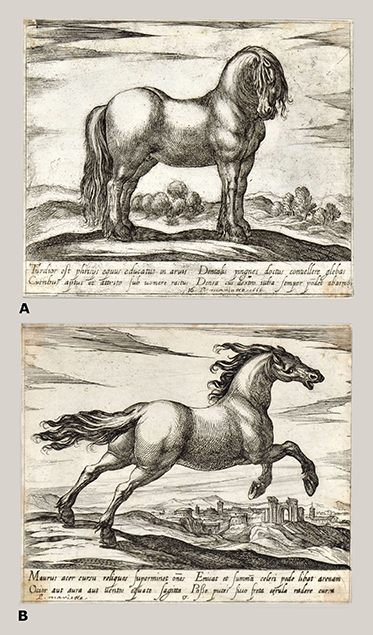(Florence 1555 - Rome 1630)
A PAIR OF ETCHINGS BY ANTONIO TEMPESTA, FROM THE COLLECTION OF PIERRE MARIETTE II, 1590
A) Standing Horse, Facing Right
B) Horse Running to the Right
Both etchings belong to the series Horses from Different Lands (1590) (Bartsch XVII.161.941–68). The series has had several editions. Both our copies certainly belong to a pristine edition, due to the rich inking and the evidence of the lines for the lettering under the image. Each circa 142 x 167 mm.
PROVENANCE: Pierre Mariette II (1634-1716)
A Inscribed In pen P mariette 1666
B Inscribed In pen P mariette
Antonio Tempesta was born and trained in Florence. He enrolled in the Accademia delle Arti del Disegno in 1576. A pupil of Santi di Tito, then of the Flemish painter Joannes Stradanus, he was part of the large team of artists working under Giorgio Vasari on the interior decoration of the Palazzo Vecchio in Florence. He then went to Rome, where he associated with artists from the Habsburg Netherlands.
Tempesta and the Flemish painter Matthijs Bril were commissioned by Pope Gregory XIII to paint wide panoramas of the Procession to Transfer the Relics of St. Gregory of Nazianzus (1572) for the loggias on the third floor of the Vatican Palace. From 1579–83, Tempesta participated in the decoration of the Villa Farnese in Caprarola and he is also known to have collaborated on frescoes in the Villa d'Este at Tivoli and the Palazzina Gamara at Villa Lante, Bagnaia. Although in Rome, Tempesta continued to earn significant commissions from Florentine patrons, including the Medici Grand Dukes.
Tempesta is now best known as a printmaker. He created more than 1,400 prints, including a large number of hunting and battle scenes. He also produced several etchings of battles between Christian soldiers and cavalry and infidel troops. These kinds of cavalry and battle scenes are also the subject of many of the artist’s drawings. Tempesta also drew many designs for tapestries. He also painted a number of easel pictures, sometimes on coloured stone.
